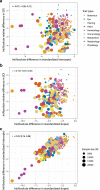Sex differences in allometry for phenotypic traits in mice indicate that females are not scaled males
- PMID: 36509767
- PMCID: PMC9744842
- DOI: 10.1038/s41467-022-35266-6
Sex differences in allometry for phenotypic traits in mice indicate that females are not scaled males
Abstract
Sex differences in the lifetime risk and expression of disease are well-known. Preclinical research targeted at improving treatment, increasing health span, and reducing the financial burden of health care, has mostly been conducted on male animals and cells. The extent to which sex differences in phenotypic traits are explained by sex differences in body weight remains unclear. We quantify sex differences in the allometric relationship between trait value and body weight for 363 phenotypic traits in male and female mice, recorded in >2 million measurements from the International Mouse Phenotyping Consortium. We find sex differences in allometric parameters (slope, intercept, residual SD) are common (73% traits). Body weight differences do not explain all sex differences in trait values but scaling by weight may be useful for some traits. Our results show sex differences in phenotypic traits are trait-specific, promoting case-specific approaches to drug dosage scaled by body weight in mice.
© 2022. The Author(s).
Conflict of interest statement
The authors declare no competing interests.
Figures




Similar articles
-
Urban-Rural Differences in Eye, Bill, and Skull Allometry in House Finches (Haemorhous mexicanus).Integr Comp Biol. 2016 Dec;56(6):1215-1224. doi: 10.1093/icb/icw077. Epub 2016 Jul 1. Integr Comp Biol. 2016. PMID: 27371388
-
Rensch's rule: linking intraspecific to evolutionary allometry.Evolution. 2023 Dec 2;77(12):2576-2589. doi: 10.1093/evolut/qpad172. Evolution. 2023. PMID: 37738625
-
Scaling of Morphological Characters across Trait Type, Sex, and Environment.Am Nat. 2016 Jan;187(1):89-98. doi: 10.1086/684159. Epub 2015 Nov 20. Am Nat. 2016. PMID: 27277405
-
Sexual selection and allometry: a critical reappraisal of the evidence and ideas.Evolution. 2007 Apr;61(4):838-49. doi: 10.1111/j.1558-5646.2007.00081.x. Evolution. 2007. PMID: 17439616 Review.
-
Evolution of morphological allometry.Ann N Y Acad Sci. 2014 Jul;1320:58-75. doi: 10.1111/nyas.12470. Epub 2014 Jun 9. Ann N Y Acad Sci. 2014. PMID: 24913643 Review.
Cited by
-
Interactions between Gender and Sepsis-Implications for the Future.Microorganisms. 2023 Mar 14;11(3):746. doi: 10.3390/microorganisms11030746. Microorganisms. 2023. PMID: 36985319 Free PMC article. Review.
-
Genetic hypogonadal (Gnrh1hpg) mouse model uncovers influence of reproductive axis on maturation of the gut microbiome during puberty.bioRxiv [Preprint]. 2024 Jul 2:2024.07.01.601610. doi: 10.1101/2024.07.01.601610. bioRxiv. 2024. PMID: 39005422 Free PMC article. Preprint.
-
Sexual dimorphism in skull size and shape of Laticauda colubrina (Serpentes: Elapidae).PeerJ. 2023 Oct 18;11:e16266. doi: 10.7717/peerj.16266. eCollection 2023. PeerJ. 2023. PMID: 37868070 Free PMC article.
-
Temperature and nutrition do not interact to shape the evolution of metabolic rate.Philos Trans R Soc Lond B Biol Sci. 2024 Feb 26;379(1896):20220484. doi: 10.1098/rstb.2022.0484. Epub 2024 Jan 8. Philos Trans R Soc Lond B Biol Sci. 2024. PMID: 38186272 Free PMC article.
-
Unmasking the Adverse Impacts of Sex Bias on Science and Research Animal Welfare.Animals (Basel). 2023 Sep 2;13(17):2792. doi: 10.3390/ani13172792. Animals (Basel). 2023. PMID: 37685056 Free PMC article. Review.
References
-
- Mogil, J. S. & Chanda, M. L. The case for the inclusion of female subjects in basic science studies of pain. PAIN117, 1–5 (2005). - PubMed
Publication types
MeSH terms
Grants and funding
LinkOut - more resources
Full Text Sources

